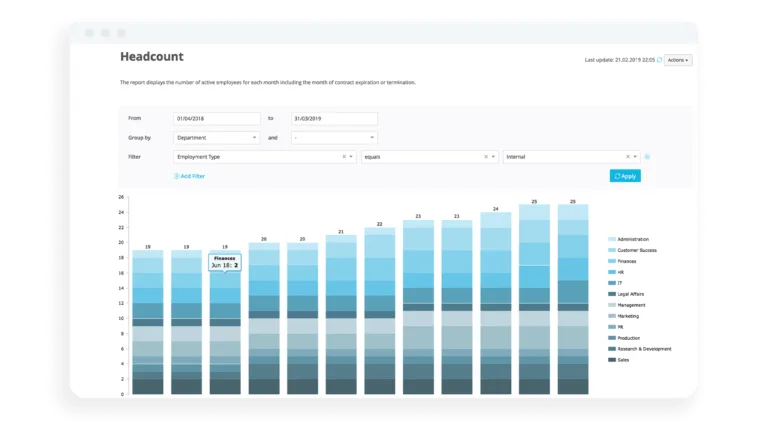Revitalising personnel management: Powering business success

In today's modern organisation, effective personnel management is pivotal in propelling organisational growth and ensuring a business thrives.
From our perspective, it spans seven crucial areas—so where do you start? In this article, we offer everything you need to know to become an expert in personnel management.
What is personnel management?
Personnel management is a specialised field within business management that focuses on workforce-related issues. It encompasses all strategies, actions and activities aimed at helping the company grow, including through change management initiatives.
In large corporations, personnel management is often equated with the personnel department. However, it's not a responsibility exclusive to this division; every manager in the company should engage in personnel management practices.
Let's consider five key examples of personnel management:
Strategy
Planning and organisation
Staff development
Personnel administration
Human resources oversight
Over the years, personnel management has evolved significantly. Since the early '90s, there's been a growing recognition that employees are a crucial asset for a business. Nowadays, personnel management acknowledges that each individual contributes uniquely to a company's success, beyond being mere "human capital."
Key responsibilities of personnel management
In an era marked by talent wars, demographic shifts and skills shortages, the central role of personnel management is to ensure all departments are staffed with qualified professionals. Businesses can't succeed long-term without a skilled workforce, making personnel management an essential aspect of strategic planning.
Seven key tasks stem from this:
Workforce planning: What skills are required and how many staff are needed?
Recruitment: Sourcing talent internally and externally through the right channels
Personnel administration and communication: Overseeing everything from onboarding to exit, while also managing internal and external communications
Payroll management: Establishing remuneration policies, from base pay to bonuses
Staff development and retention: Training and other development initiatives, along with job enrichment and rotation
Performance reviews: Assessing employee performance and potential
People analytics and KPIs: Managing personnel processes based on key performance indicators
These tasks aim for long-term organisational development and sustaining a competitive edge. They can be either strategic, like payroll and staff development, or transactional, like administration and personnel control.
Goals of personnel management
Effective personnel management significantly boosts a company's performance. A high-performing personnel team aligns itself with three strategic company goals:
Goal 1: Aligning corporate and employee objectives
The ultimate challenge in personnel management is to synchronise employee desires with business goals. For example, employees' personal lives often conflict with corporate objectives, like profit maximisation. Current generations, especially, are skeptical of a solely economic focus.
According to a study by Personio, 29% of employees prioritise work-life balance, followed by enhanced internal communication and career development opportunities.
Note: While 73% of personnel leaders believe their teams enjoy good work-life balance, only 65% of staff agree.
Personnel management should actively address these discrepancies by fostering a motivating work environment.
Goal 2: Enhancing employee engagement
Success in personnel management also involves retaining the right employees for the long term. Numerous studies have shown that satisfied workers are more productive and creative. To achieve this, utilise every employee retention strategy, such as career progression frameworks and future planning.
Goal 3: Boost competitiveness through cost efficiency
When personnel management excels at employee satisfaction and retention, reduced personnel costs naturally follow. This leads to less frequent hiring and training, and fewer absences, resulting in lower costs and enhanced competitiveness.
Metrics for evaluating personnel management
Two main indicators include:
Turnover Rate: | This can be tracked company-wide or departmentally. If certain teams show high turnover, it triggers a need for investigation and action. |
Absenteeism Rate: | High levels of absenteeism can severely impact a business. When these figures remain high or are escalating, it's time to scrutinise working conditions and implement changes. |
The Modern Face of Personnel Management
Today’s personnel management is defined by its willingness to adapt and change. Gone are the days when personnel were merely an administrative function.
In today’s world, personnel management not only supports the managers of all departments operationally but also functions as a well-integrated service provider, turning them into de facto "personnel ambassadors."
A holistic approach in personnel management balances the dynamics among various organisational players, steering everyone toward shared success.
The role of personnel has thus evolved from being a basic administrator to a strategic advisor to upper management.
Looking ahead to the future of personnel management
For instance, digitalisation leads to an increasing number of IT-driven processes. This shift means that personnel managers are focusing less on routine administrative tasks—thanks to digital workflows—and more on strategic projects. Workflow management systems can be invaluable in overseeing and automating these processes.
Furthermore, the significance of physical office spaces and traditional work environments is diminishing due to digital transformation. In crisis situations, this becomes even more apparent: a large segment of the workforce can operate remotely, presenting personnel management with new challenges in diagnostics and oversight.
In conclusion, modern personnel management must be agile, adaptive, and forward-thinking to meet the evolving needs of businesses and their employees. By embracing strategic roles and leveraging technology, personnel management transforms from a mere administrative function into an essential strategic partner for the organisation. Therefore, mastering the various facets of personnel management is not just an operational necessity but a strategic imperative for contemporary businesses.
Strategic personnel management is crucial
Is your team set up for success when it comes to managing your workforce? If you feel like your processes could use a boost, you should immediately consider an all-in-one HR software that can collect employee data, streamline tasks and produce reports.
Personio is a solution designed for European SMEs who want to get more out of their people, while saving time and budget. Speak with an expert today about your top challenges and how we can help solve for them.
Disclaimer
We would like to inform you that the contents of our website (including any legal contributions) are for non-binding informational purposes only and does not in any way constitute legal advice. The content of this information cannot and is not intended to replace individual and binding legal advice from e.g. a lawyer that addresses your specific situation. In this respect, all information provided is without guarantee of correctness, completeness and up-to-dateness.

